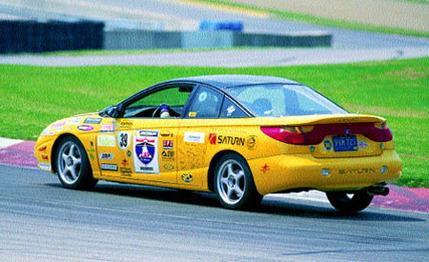 Specialty File
Specialty File
A funny thing happened during the 2001 running of the Michelin One Lap of America. Okay, all kinds of funny things happen during the course of a One Lap.
Along about round four, at Heartland Park Topeka, we noticed that a Saturn coupe was running racetrack lap times in the top 20, right up there with some of the big dogs-Corvettes, Porsches, BMWs, Mustangs, Camaros.
But wait a minute. Wasn't this the same Saturn that wound up 33rd last year? Second in the Economy Car class? Behind an old Dodge Daytona CS Turbo? And now suddenly it's a rocket? What's up with that?
Force-feeding, that's what. After chasing that old turbo car, the kids from Saturn-that's right, a full factory effort-realized this game requires horsepower. So when they came back this year, their eye-catching arrest-me-yellow coupe had a Garrett T3 turbocharger twirling under its hood-a hood punctuated by a rear-facing carbon-fiber scoop to extract heat from the engine bay, plus a NACA duct for the intake system.
The turbocharger and the allied intercooler are part of a Turbonetics kit that includes a dashboard control which allows the driver to vary boost pressure up to about 6.5 psi during competition. To combat detonation, the team reduced compression of the twin-cam, 16-valve four from 9.5:1 to 8.5:1, then expanded its displacement from 1901 cubic centimeters to 2091 by increasing the cylinder bore from 82 to 86 millimeters.
At maximum boost, the modified motor was capable of 220 horsepower, compared with 124 for the stock engine.
As you'd expect, this upgrade alone made for a considerably sassier Saturn. But the team altered the power-to-weight ratio even more by whittling industriously at the car's curb weight. The rear window, for example, is Lexan, a see-through plastic, rather than glass, and the interior is short on insulation and trim-although the air-conditioning system was retained. Ready to rumble, the coupe weighed in at 2350 pounds, compared with 2460 pounds for a stock SC2. (Incidentally, comparisons with stock Saturn SCs are tricky here, because the One Lap car is a neither/nor-it's an SC2 twin-cam engine in an SC1 body.)
The net-net of all the foregoing-plus a LUK clutch, lower fourth- and fifth-gear ratios, and a Torsen limited-slip differential-is acceleration of a rather high order for a car of such modest origins: 0 to 60 mph in 5.2 seconds, 0 to 100 in 11.4. In contrast, the last Saturn SC2 to pass through Car and Driver (April 1999) hit those same marks in 8.2 and 26.0 seconds. Another contrast: The last Porsche Boxster S we tested (August 2001) hit 60 in 5.3 seconds and 100 in 13.5.